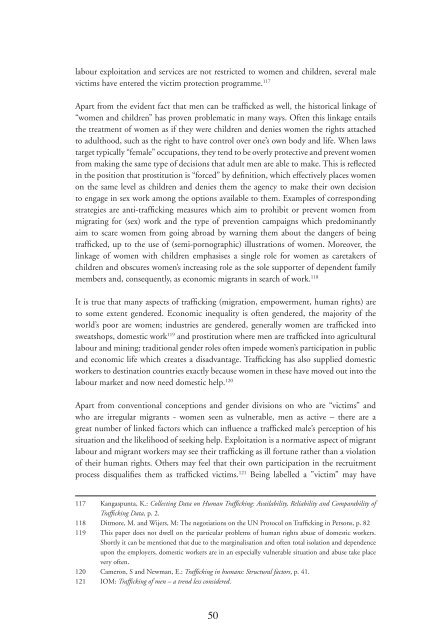Trafficking in human beings: human rights and ... - unesdoc - Unesco
Trafficking in human beings: human rights and ... - unesdoc - Unesco
Trafficking in human beings: human rights and ... - unesdoc - Unesco
Create successful ePaper yourself
Turn your PDF publications into a flip-book with our unique Google optimized e-Paper software.
labour exploitation <strong>and</strong> services are not restricted to women <strong>and</strong> children, several male<br />
victims have entered the victim protection programme. 117<br />
Apart from the evident fact that men can be traffi cked as well, the historical l<strong>in</strong>kage of<br />
“women <strong>and</strong> children” has proven problematic <strong>in</strong> many ways. Often this l<strong>in</strong>kage entails<br />
the treatment of women as if they were children <strong>and</strong> denies women the <strong>rights</strong> attached<br />
to adulthood, such as the right to have control over one’s own body <strong>and</strong> life. When laws<br />
target typically “female” occupations, they tend to be overly protective <strong>and</strong> prevent women<br />
from mak<strong>in</strong>g the same type of decisions that adult men are able to make. This is refl ected<br />
<strong>in</strong> the position that prostitution is “forced” by defi nition, which effectively places women<br />
on the same level as children <strong>and</strong> denies them the agency to make their own decision<br />
to engage <strong>in</strong> sex work among the options available to them. Examples of correspond<strong>in</strong>g<br />
strategies are anti-traffi ck<strong>in</strong>g measures which aim to prohibit or prevent women from<br />
migrat<strong>in</strong>g for (sex) work <strong>and</strong> the type of prevention campaigns which predom<strong>in</strong>antly<br />
aim to scare women from go<strong>in</strong>g abroad by warn<strong>in</strong>g them about the dangers of be<strong>in</strong>g<br />
traffi cked, up to the use of (semi-pornographic) illustrations of women. Moreover, the<br />
l<strong>in</strong>kage of women with children emphasises a s<strong>in</strong>gle role for women as caretakers of<br />
children <strong>and</strong> obscures women’s <strong>in</strong>creas<strong>in</strong>g role as the sole supporter of dependent family<br />
members <strong>and</strong>, consequently, as economic migrants <strong>in</strong> search of work. 118<br />
It is true that many aspects of traffi ck<strong>in</strong>g (migration, empowerment, <strong>human</strong> <strong>rights</strong>) are<br />
to some extent gendered. Economic <strong>in</strong>equality is often gendered, the majority of the<br />
world’s poor are women; <strong>in</strong>dustries are gendered, generally women are traffi cked <strong>in</strong>to<br />
sweatshops, domestic work 119 <strong>and</strong> prostitution where men are traffi cked <strong>in</strong>to agricultural<br />
labour <strong>and</strong> m<strong>in</strong><strong>in</strong>g; traditional gender roles often impede women’s participation <strong>in</strong> public<br />
<strong>and</strong> economic life which creates a disadvantage. Traffi ck<strong>in</strong>g has also supplied domestic<br />
workers to dest<strong>in</strong>ation countries exactly because women <strong>in</strong> these have moved out <strong>in</strong>to the<br />
labour market <strong>and</strong> now need domestic help. 120<br />
Apart from conventional conceptions <strong>and</strong> gender divisions on who are “victims” <strong>and</strong><br />
who are irregular migrants - women seen as vulnerable, men as active – there are a<br />
great number of l<strong>in</strong>ked factors which can <strong>in</strong>fl uence a traffi cked male’s perception of his<br />
situation <strong>and</strong> the likelihood of seek<strong>in</strong>g help. Exploitation is a normative aspect of migrant<br />
labour <strong>and</strong> migrant workers may see their traffi ck<strong>in</strong>g as ill fortune rather than a violation<br />
of their <strong>human</strong> <strong>rights</strong>. Others may feel that their own participation <strong>in</strong> the recruitment<br />
process disqualifi es them as traffi cked victims. 121 Be<strong>in</strong>g labelled a ”victim” may have<br />
117 Kangaspunta, K.: Collect<strong>in</strong>g Data on Human Traffi ck<strong>in</strong>g: Availability, Reliability <strong>and</strong> Comparability of<br />
Traffi ck<strong>in</strong>g Data, p. 2.<br />
118 Ditmore, M. <strong>and</strong> Wijers, M: The negotiations on the UN Protocol on Traffi ck<strong>in</strong>g <strong>in</strong> Persons, p. 82<br />
119 This paper does not dwell on the particular problems of <strong>human</strong> <strong>rights</strong> abuse of domestic workers.<br />
Shortly it can be mentioned that due to the marg<strong>in</strong>alisation <strong>and</strong> often total isolation <strong>and</strong> dependence<br />
upon the employers, domestic workers are <strong>in</strong> an especially vulnerable situation <strong>and</strong> abuse take place<br />
very often.<br />
120 Cameron, S <strong>and</strong> Newman, E.: Traffi ck<strong>in</strong>g <strong>in</strong> <strong>human</strong>s: Structural factors, p. 41.<br />
121 IOM: Traffi ck<strong>in</strong>g of men – a trend less considered.<br />
50

















